
Index
Applications & Benefits of GAO’s RFID, BLE, IoT & Drones for General Freight Trucking Industry
GAO Software Provides Easy Integration with API
Case Studies of RFID, IoT & Drone Applications
GAO RFID Systems & Hardware for General Freight Trucking Industry
GAO Makes Efforts to Satisfy Customers
GAO Has Served General Freight Trucking Industry Extensively
Overview
The general freight trucking industry encompasses the transportation of a wide range of goods and cargo using trucks as the primary mode of transportation. This sector plays a pivotal role in moving goods efficiently and reliably across regions and countries, serving the needs of businesses and consumers alike. General freight trucking companies handle everything from raw materials to finished products and consumer goods, offering a versatile and essential service within the broader logistics and supply chain ecosystem. This industry operates in a competitive market, adhering to regulations governing safety, environmental standards, and driver hours, while also embracing technology to optimize operations and enhance efficiency. Additionally, there is a growing emphasis on environmental sustainability, with efforts to reduce the industry’s environmental footprint through cleaner fuels and more eco-friendly practices.
GAO’s RFID, BLE, IoT, and drone technologies have helped its customers in general freight trucking industry to improve their work processes, their operations and productivity by better management of their staff, materials and operational equipment such as Trucks (e.g., tractor-trailers, box trucks, flatbeds), Trailers (e.g., dry vans, refrigerated trailers), Load securing equipment (e.g., straps, chains, binders), Forklifts and pallet jacks, GPS and navigation systems, Communication equipment (e.g., CB radios), Safety equipment (e.g., fire extinguishers, reflective vests), Loading docks and ramps, Weigh scales, Maintenance tools and equipment, Tarping systems for open trailers, Fuel tanks and pumps, Tire repair and maintenance tools, Cargo monitoring and tracking systems, Electronic logging devices (ELDs), Hydraulic lifts for heavy cargo, Hazardous materials handling equipment, Dock levelers, Fuel-efficient technologies (e.g., aerodynamic devices), Onboard computer systems for dispatch and record-keeping.
Ranked as one of the top 10 global RFID suppliers, GAO RFID Inc. is based in New York City, U.S. and Toronto, Canada. GAO offers a comprehensive selection of UHF, HF (including NFC) and LF RFID (radio frequency identification) readers and tags, BLE (Low Energy Bluetooth) gateways and beacons, and various RFID and BLE systems such as people tracking, asset tracking, access control, parking control, fleet management, WIP (work in progress), traceability. Such RFID and BLE products and systems, as well as its IoT and drone technologies, have been successfully deployed for general freight trucking industry. Its sister company, GAO Tek Inc. https://gaotek.com, is a leading supplier of industrial or commercial testers and analyzers, drones, and network products.
The targeted markets of both GAO RFID Inc. and GAO Tek Inc. are North America, particularly the U.S., Canada, Mexico, and Europe. As a result, this website gaorfid.com is offered in English and other major languages of North America and Europe such as Spanish, French, German, Italian, Polish, Ukrainian, Romanian, Russian, Dutch, Turkish, Greek, Hungarian, Swedish, Czech, Portuguese, Serbian, Bulgarian, Croatian, Danish, Finnish, Norwegian, Slovak, Catalan, Lithuanian, Bosnian, Galician, Slovene, Latvian, Estonian, Welsh, Icelandic, and Irish.
Applications &Benefits of GAO’s RFID, BLE, IoT & Drones for General Freight Trucking Industry
 To satisfy its customers, GAO’s RFID or RFID Systems for general freight trucking industry are offered in 2 versions. One version is that its software is running on a local server that normally is on our client’s premise, and another version runs in the cloud. The cloud server could be GAO’s cloud server, client’s own cloud server or a cloud server from one of the leading cloud server providers such as Amazon Web Services (AWS), Microsoft Azure, Google Cloud, IBM Cloud (formerly SoftLayer), Oracle Cloud, RedHat, Heroku, Digital Ocean, CloudFlare, Linode and Rackspace. The above illustrates GAO system for sub-industry with its software running on a local server.
To satisfy its customers, GAO’s RFID or RFID Systems for general freight trucking industry are offered in 2 versions. One version is that its software is running on a local server that normally is on our client’s premise, and another version runs in the cloud. The cloud server could be GAO’s cloud server, client’s own cloud server or a cloud server from one of the leading cloud server providers such as Amazon Web Services (AWS), Microsoft Azure, Google Cloud, IBM Cloud (formerly SoftLayer), Oracle Cloud, RedHat, Heroku, Digital Ocean, CloudFlare, Linode and Rackspace. The above illustrates GAO system for sub-industry with its software running on a local server.
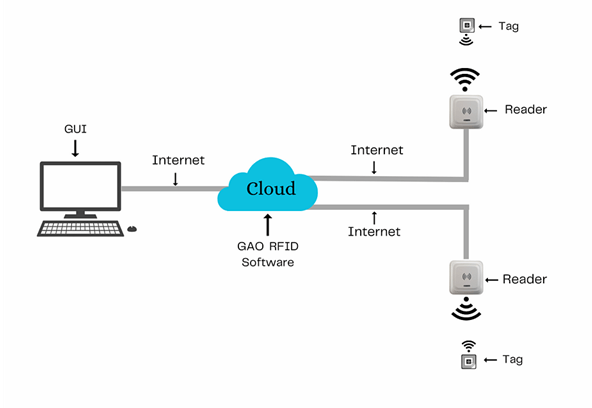 The above illustrates GAO system for general freight trucking industry with its software running in cloud.
The above illustrates GAO system for general freight trucking industry with its software running in cloud.
GAO’s RFID and BLE technologies, consisting of RFID readers, RFID tags, BLE gateways, BLE beacons, software, cloud services and their systems, have the following applications in general freight trucking industry:
- Inventory Management: GAO’s RFID tags can be used to track and manage inventory in real-time, making it easier to locate and account for cargo items within a truck.
- Asset Tracking: GAO’s RFID tags can be attached to various assets, such as trailers, containers, and equipment, allowing for efficient tracking and management of these assets.
- Cargo Monitoring: GAO’s RFID sensors and tags can monitor the condition of cargo, including temperature, humidity, and shock. This is especially valuable for perishable goods and fragile items.
- Security: GAO’s RFID can enhance security by monitoring access to trailers and containers. Unauthorized access can trigger alerts, helping to prevent theft and tampering.
- Load Optimization: GAO’s RFID can help optimize the loading process by ensuring that the right items are loaded onto the correct trucks, reducing errors and improving efficiency.
- Maintenance Tracking: GAO’s RFID tags can be used to track maintenance schedules for trucks and equipment, ensuring they are in proper working condition.
- Yard Management: GAO’s RFID technology can streamline yard management by tracking the movement of trucks, trailers, and containers within a freight yard or distribution center.
- Supply Chain Visibility: GAO’s RFID can provide real-time visibility into the movement of goods along the supply chain, allowing for better coordination and responsiveness to disruptions.
- Document Management: GAO’s RFID can be used to manage and track shipping documents, making it easier to retrieve and verify paperwork associated with shipments.
- Gate Entry and Exit: GAO’s RFID tags can automate gate entry and exit processes, expediting the check-in and check-out of trucks at distribution centers and terminals.
- Electronic Seals: GAO’s RFID-enabled electronic seals can enhance cargo security by providing tamper-evident seals that can be monitored remotely.
- Compliance and Documentation: GAO’s RFID can help ensure compliance with regulations by automating the tracking and reporting of data required for regulatory purposes, such as transportation of hazardous materials.
- Route Optimization: GAO’s RFID data, when combined with GPS and other technologies, can be used to optimize truck routes, reduce fuel consumption, and improve delivery efficiency.
- Real-time Updates: GAO’s RFID technology can provide real-time updates to customers and logistics partners about the status and location of shipments, enhancing transparency and customer service.
- Returnable Packaging: GAO’s RFID tags on returnable packaging items, such as pallets and containers, can help manage the return and reuse of these assets efficiently.
- Load Balancing: GAO’s RFID can assist in balancing loads on trucks to ensure even weight distribution and compliance with weight regulations.
GAO’s drone technologies find the following applications in the general freight trucking industry:
- Last-Mile Delivery: GAO’s Drones can be used for delivering packages directly to customers’ doorsteps, especially in remote or difficult-to-access areas, enhancing the efficiency of last-mile logistics.
- Remote Area Access: GAO’s Drones can transport cargo to areas with limited road access, such as rural or disaster-stricken areas, providing timely relief and support.
- Traffic Monitoring: GAO’s Drones can monitor traffic conditions on highways and provide real-time updates to truck drivers, helping them avoid congested routes and delays.
- Aerial Surveys: GAO’s Drones equipped with cameras and sensors can perform aerial surveys of shipping yards, terminals, and storage facilities to assess cargo status, security, and capacity.
- Inventory Management: GAO’s Drones can assist in inventory management by conducting aerial scans of warehouses, verifying stock levels, and identifying discrepancies.
- Environmental Monitoring: GAO’s Drones can monitor environmental conditions, such as weather, temperature, and air quality, which can impact cargo safety during transportation.
- Security and Surveillance: GAO’s Drones equipped with cameras and sensors can enhance security by monitoring the perimeter of freight yards, detecting unauthorized access, and preventing theft.
- Traffic Accident Response: GAO’s Drones can be deployed to assess the scene of a traffic accident involving freight trucks, aiding in investigations and improving response times.
- Cargo Inspection: GAO’s Drones equipped with specialized sensors can inspect cargo containers for damage, leaks, or other issues, reducing the need for manual inspections.
- Search and Rescue: GAO’s In cases of accidents or emergencies involving freight trucks, drones can assist in search and rescue operations by providing aerial views and locating individuals in distress.
- Cargo Tracking: GAO’s Drones can carry RFID or GPS equipment to track the location and condition of cargo during transit, providing real-time updates to logistics operators.
- Traffic Management: GAO’s Drones can assist in managing traffic flow around freight terminals and ports, reducing congestion and improving truck access.
- Emergency Response: GAO’s Drones can transport emergency supplies and medical equipment to accident sites or disaster areas to provide immediate assistance.
- Bridge and Infrastructure Inspection: GAO’s Drones can inspect bridges, overpasses, and other infrastructure along trucking routes, helping to identify maintenance needs and potential hazards.
- Environmental Compliance: GAO’s Drones can monitor trucking operations for compliance with environmental regulations, such as emissions and spill control.
- Route Planning: GAO’s Drones can scout potential routes for freight trucks, assessing road conditions, obstacles, and weather conditions to optimize transportation plans.
- Documentation and Photography: GAO’s Drones can capture high-resolution images and videos of freight trucks, cargo, and logistics operations for documentation and analysis.
GAO’s IoT technologies, consisting of IoT sensors, sensors networks and systems, find the following applications in the general freight trucking industry:
- Asset Tracking: GAO’s IoT sensors can be used to track the location and condition of trucks, trailers, containers, and other assets in real-time, providing logistics managers with visibility and control over their fleet.
- Cargo Monitoring: GAO’s IoT sensors can monitor the condition of cargo, including temperature, humidity, and shock, ensuring that goods are transported under optimal conditions, especially for perishable or sensitive cargo.
- Predictive Maintenance: GAO’s IoT sensors on trucks and equipment can collect data on engine performance, tire pressure, and other factors to predict maintenance needs, reducing downtime and maintenance costs.
- Fuel Efficiency: GAO’s IoT devices can monitor fuel consumption and driver behavior (e.g., excessive idling), helping companies optimize fuel efficiency and reduce fuel costs.
- Route Optimization: GAO’s IoT data, combined with GPS and traffic information, can optimize truck routes in real-time, reducing delivery times and fuel consumption.
- Safety Monitoring: GAO’s IoT can enhance driver safety by monitoring factors like driver fatigue, harsh braking, and speeding, providing alerts to drivers and fleet managers to improve safety.
- Remote Diagnostics: GAO’s IoT-enabled diagnostics systems can remotely identify and troubleshoot mechanical issues in trucks, minimizing downtime and repair costs.
- Environmental Monitoring: GAO’s IoT sensors can monitor emissions and environmental factors, helping trucking companies comply with emissions regulations and reduce their carbon footprint.
- Load Management: GAO’s IoT sensors can monitor the weight and distribution of cargo loads, ensuring compliance with weight limits and improving load balance for safety and efficiency.
- Inventory Management: GAO’s IoT can be used to track inventory levels in real-time, helping warehouses and distribution centers manage stock efficiently.
- Security and Theft Prevention: GAO’s IoT sensors and cameras can enhance security by monitoring the perimeter of freight yards and vehicles, alerting authorities to unauthorized access or cargo tampering.
- Supply Chain Visibility: GAO’s IoT data can provide real-time visibility into the movement of goods throughout the supply chain, allowing for better coordination and responsiveness to disruptions.
- Cold Chain Management: GAO’s IoT sensors can monitor temperature-sensitive cargo, such as pharmaceuticals and food products, ensuring they remain within specified temperature ranges during transportation.
- Documentation and Compliance: GAO’s IoT can automate documentation processes, ensuring compliance with regulations and streamlining paperwork associated with shipments.
- Customer Service: GAO’s IoT data can be shared with customers to provide real-time updates on the status and location of shipments, improving customer service and transparency.
- Insurance and Risk Management: GAO’s IoT data can be used for risk assessment and insurance purposes, helping trucking companies manage insurance costs and claims.
GAO Helps Customers Comply with Standards, Mandates & Regulations of General Freight Trucking Industry
GAO RFID Inc. has helped many companies in general freight trucking industry to deploy RFID, BLE, IoT and drone systems and to ensure such deployments complying with the applicable industry standards, mandates and government regulations:
RFID, BLE, IoT, & Drone Standards & Mandates
- EPC Global Gen2
- ISO 18000-6C
- ISO 14443 (NFC)
- Bluetooth 4.0 (Bluetooth Smart)
- Bluetooth 4.2
- Bluetooth 5.0
- Bluetooth 5.1
- Bluetooth 5.2
- MQTT (Message Queuing Telemetry Transport)
- CoAP (Constrained Application Protocol)
- OPC UA (Unified Architecture)
- LoRaWAN (Long Range Wide Area Network)
- Zigbee
- Thread (IPv6 over Low-Power Wireless Personal Area Networks)
- Sigfox
- Cellular IoT (e.g., LTE-M, NB-IoT)
- ASTM F38 (Unmanned Aircraft Systems)
- ISO 21384 (Unmanned Aircraft Systems)
- FAA Part 107 (U.S. Federal Aviation Administration regulations for commercial drones)
- EASA (European Union Aviation Safety Agency) regulations for drones
- ICAO (International Civil Aviation Organization) RPAS (Remotely Piloted Aircraft Systems) regulations
US. Government Regulations
- Federal Motor Carrier Safety Regulations (FMCSRs)
- Hours of Service (HOS) Regulations
- Commercial Driver’s License (CDL) Regulations
- Electronic Logging Device (ELD) Mandate
- Hazardous Materials Regulations (HMRs)
- Size and Weight Regulations
- Drug and Alcohol Testing Regulations
- Vehicle Inspection and Maintenance Regulations
- Federal Motor Carrier Safety Administration (FMCSA) Regulations
- Trucking Economic Regulatory Requirements (MC Numbers)
- Environmental Regulations (e.g., emissions standards)
- Transportation Security Administration (TSA) Regulations (for hazmat shipments)
- Federal Bridge Formula Regulations
- National Highway Traffic Safety Administration (NHTSA) Regulations (for vehicle safety)
- Unified Carrier Registration (UCR) Regulations
- Federal Trade Commission (FTC) Regulations (for consumer protection)
- Interstate Commerce Commission (ICC) Regulations (historical, now abolished)
Canadian Government Regulations
- Motor Vehicle Transport Act
- Transportation of Dangerous Goods Act
- National Safety Code (NSC) for Motor Carriers
- Hours of Service Regulations
- Commercial Vehicle Drivers Hours of Service Regulations
- Electronic Logging Device (ELD) Mandate
- Weight and Dimension Regulations
- Vehicle Inspection and Maintenance Regulations
- Dangerous Goods Transportation Regulations
- Transportation Appeal Tribunal of Canada (TATC) Regulations
- Canadian Transportation Agency (CTA) Regulations
- Customs and Excise Regulations (for international freight)
- National Emission Marking Regulations (for emissions control)
- Canada Border Services Agency (CBSA) Regulations (for cross-border trade)
- Temporary Foreign Worker Program (TFWP) Regulations (for foreign drivers)
- Environmental Protection Regulations (e.g., emissions standards)
- Workplace Safety and Insurance Board (WSIB) Regulations (for worker safety)
GAO Software Provides Easy Integration with API
GAO’s RFID and BLE software offers a free trial for both the server-based and cloud versions, and offers an API to the important systems in general freight trucking industry such as:
Personnel Management:
- Driver Scheduling and Dispatching
- Driver Training and Certification Tracking
- Payroll and Compensation Management
- Driver Performance Monitoring
- Compliance with Hours of Service (HOS) Regulations
Equipment Management:
- Vehicle Maintenance and Repairs Tracking
- Fuel and Fleet Management
- Asset Tracking (Trailers, Containers)
- Load Balancing and Weight Distribution
Access Control:
- Gate Entry and Exit Management
- Security Surveillance and Monitoring
- Cargo and Facility Access Control
Warehouse Management:
- Inventory Management
- Cargo Tracking and Tracing
- Cross-Docking Operations
- Dock and Yard Management
Supply Chain Management:
- Route Optimization and Planning
- Real-time Shipment Visibility
- Demand Forecasting
- Vendor and Supplier Management
- Reverse Logistics
Other Applications:
- Electronic Logging Devices (ELD) Compliance
- Hazardous Materials (Hazmat) Handling
- Cold Chain Management (Temperature Monitoring)
- Document Management and Compliance
- Customer Relationship Management (CRM)
- Environmental Sustainability and Emission Tracking
GAO has enabled its customers to make use of some of the leading software and cloud services in general freight trucking industry. Below are some of popular software and cloud services in general freight trucking industry.
Workday, Oracle HCM Cloud, SAP SuccessFactors, ADP Workforce Now, Kronos Workforce Central, Samsara, Geotab, Teletrac Navman, Fleet Complete, Verizon Connect, Genetec Security Center, Brivo OnAir, LenelS2 OnGuard, Avigilon Control Center, Open Options DNA Fusion, Manhattan Associates WMS, Blue Yonder (formerly JDA Software) WMS, Oracle WMS Cloud, HighJump WMS (now part of Korber), Infor WMS (CloudSuite WMS), Blue Yonder (formerly JDA Software) SCM, Kinaxis RapidResponse, SAP Integrated Business Planning (IBP), Oracle SCM Cloud, Descartes Systems Group.
GAO has worked with some of the leading technology companies in general freight trucking industry in to provide integrated its RFID, BLE, IoT and drone solutions to customers. Here are some of the technology leaders in general freight trucking industry:
Trimble Transportation, Omnitracs, Samsara, Geotab, ORBCOMM, PeopleNet Communications, Teletrac Navman, Verizon Connect, Zonar Systems, EROAD, Garmin, ID Systems (PowerFleet), TMW Systems (a Trimble Company), McLeod Software, Transflo, KeepTruckin, FourKites, Descartes Systems Group, Blue Yonder (formerly JDA Software), Manhattan Associates.
Case Studies of RFID, IoT & Drone Applications
Case Studies of RFID Applications
Below are some RFID application cases in general freight trucking industry.
Many U.S. trucking companies use RFID to track the location and status of trailers and containers. This helps improve asset utilization and prevent theft.
RFID is employed in freight yards and distribution centers across the country to monitor the movement of trucks and cargo, optimize yard operations, and reduce congestion.
RFID temperature sensors are used to monitor the temperature of refrigerated cargo during transit, ensuring compliance with food safety regulations.
RFID is used in warehouses and distribution centers to track the movement and status of inventory, improving accuracy and efficiency.
Canadian trucking companies use RFID to streamline cross-border trade with the United States, helping to expedite customs and border control processes.
RFID is used to track and monitor the transport of hazardous materials, ensuring compliance with safety regulations.
RFID technology is used at Mexican border crossings to expedite customs clearance processes for freight trucks entering or exiting the country.
RFID-based seals are used to secure cargo containers and monitor for unauthorized access or tampering during transit.
RFID-based toll collection systems are widely used on European highways to facilitate seamless and cashless toll payments for freight trucks.
In Europe, RFID is utilized to track and monitor emissions from freight trucks, ensuring compliance with environmental regulations.
RFID technology is employed to provide real-time visibility into the movement of goods across European supply chains, enhancing efficiency and responsiveness.
European logistics companies use RFID to track returned goods and manage the reverse logistics process efficiently.
Many applications of RFID by GAO can be found here.
Case Studies of IoT Applications
Below are some IoT application cases in general freight trucking industry.
Freight trucks in the USA are equipped with IoT sensors and GPS devices that provide real-time tracking and monitoring of their location and status. This helps improve route planning, delivery times, and overall logistics efficiency.
The USA has mandated the use of ELDs in commercial vehicles to track and manage drivers’ hours of service (HOS) electronically, ensuring compliance with federal regulations.
IoT sensors are used to monitor the condition of cargo, including temperature-sensitive goods, ensuring that they remain within specified temperature ranges during transit.
IoT devices collect data on the performance of truck engines and components, enabling predictive maintenance to reduce downtime and maintenance costs.
Canadian trucking companies utilize IoT sensors to monitor the temperature of refrigerated cargo during transit, particularly for the transportation of food and pharmaceuticals.
IoT-enabled tracking systems help streamline cross-border trade between Canada and the USA, ensuring visibility and security during international shipments.
IoT applications are used to optimize border crossing processes between Mexico and the United States, reducing wait times and enhancing security.
IoT telematics solutions are deployed in Mexican trucking fleets to monitor driver behavior, promote safe driving practices, and reduce accidents.
IoT-based toll collection systems are widespread in European countries, and they often integrate with fleet management solutions for efficient toll payment and route optimization.
IoT sensors are used to monitor emissions from freight trucks in compliance with strict European environmental regulations.
In European cities, IoT applications integrate with urban infrastructure to manage urban logistics efficiently, reduce congestion, and improve air quality.
IoT is applied to monitor returned goods and streamline the reverse logistics process, particularly for e-commerce shipments.
Case Studies of Drone Applications
Below are some drone application cases in general freight trucking industry.
In certain U.S. urban areas, drones have been used for last-mile delivery of small and urgent parcels to complement the final leg of freight truck deliveries, improving delivery speed and efficiency.
Drones equipped with cameras and sensors are employed for aerial monitoring of trucking yards and facilities, enhancing security and providing real-time updates on cargo status.
Drones are used to monitor traffic conditions on highways and major trucking routes, providing valuable data to truck drivers and logistics companies for route optimization and congestion avoidance.
In remote and challenging terrains in Canada, drones have been utilized to transport cargo to areas where truck access is limited or impractical, such as northern regions and mining sites.
Drones are used for search and rescue operations, assisting in locating missing trucks, drivers, or cargo in harsh and remote Canadian landscapes.
Drones are employed by Mexican customs and border control authorities to monitor and enhance security at border crossings, ensuring the smooth flow of freight truck traffic between Mexico and the USA.
Drones are used to assess and document the scenes of traffic accidents involving freight trucks, providing valuable data for investigations and insurance claims.
European logistics companies utilize drones to monitor emissions and environmental factors, helping meet stringent environmental regulations and track the carbon footprint of freight truck operations.
Drones equipped with specialized sensors and cameras inspect cargo containers, trailers, and trucks for damage, ensuring the integrity of goods during transit.
Drones scout potential routes, assess road conditions, and inspect infrastructure like bridges and overpasses, assisting in optimizing trucking routes and identifying potential hazards.
Drones perform aerial surveys of freight yards, terminals, and storage facilities to assess cargo status, security, and capacity.
GAO RFID Systems & Hardware for General Freight Trucking Industry
GAO RFID Inc. offers the largest selection of BLE gateways, BLE beacons, RFID readers, tags, antenna, printers, and integrated RFID systems for various industries, including general freight trucking industry.
BLE (Bluetooth Low Energy)
GAO offers advanced BLE gateways:
as well as versatile beacons with such important functions as temperature, humility, vibration and panic button:
GAO’s BLE technology is suitable for many industries, including general freight trucking industry.
UHF (Ultra High Frequency) RFID
GAO offers the largest selection of UHF RFID readers for various industries, including general freight trucking industry:
GAO RFID offers the widest choice of UHF RFID tags, labels, badges, wristbands for various industries, including general freight trucking industry:
and an array of antennas to address different applications:
HF (High Frequency), NFC (Near Field Communications) and LF (Low Frequency) RFID
GAO offers the largest selection of HF, NFC, and LF RFID readers for various industries, including general freight trucking industry:
HF, NFC and LF RFID tags, labels, badges, wristbands for various industries, including general freight trucking industry:
and antennas:
GAO also offers RFID printers:
Digital I/O adapters:
and relay controllers:
For embedded applications, GAO offers UHF, HF and LF RFID reader modules:
- UHF 860 – 960 MHz RFID Modules
- 13.56 MHz High Frequency RFID Modules
- 125 kHz Low Frequency RFID Modules
In collaboration with its sister company GAO Tek Inc, a wide selection of high-quality drones is offered:
The RFID systems by GAO are highly popular for clients in general freight trucking industry:
Physical asset or operational equipment tracking system:
Assets that can be effectively tracked using GAO’s technologies include
Liftgates, Refrigerated trailers, Flatbed trailers, Dry van trailers, Tarping systems, Roll-off trucks, Tanker trucks, Auto haulers, Lowboy trailers, Dump trucks, Intermodal containers, Pallet jacks, Forklifts, Scales and weighbridges, Hazmat placards and labels, Cargo securement equipment (straps, chains, binders), Air suspension systems, Lift axles, Electronic logging devices (ELDs), GPS and navigation systems, Tire chains, E-track systems, Load bars and load locks, Safety cones and warning signs, Tarps and cargo covers, Cargo nets and straps, Dock levelers and dock plates, Load monitoring and tracking systems, APU (Auxiliary Power Unit) for sleeper cabs, Camera systems (dashcams, backup cameras), Tire pressure monitoring systems (TPMS), Trailer tracking and telematics devices, Electronic brake controllers, In-cab refrigerators, Dual fuel tanks, Hazardous materials storage cabinets, Electronic toll collection transponders, Fuel tanks and fuel management systems, APU (Auxiliary Power Unit) for temperature control in refrigerated trailers, Weight distribution and load-balancing equipment.
People or workers tracking system:
Personnel or people access control system:
Parking or vehicle control system:
Furthermore, GAO provides the customization of RFID tags, RFID readers, BLE beacons and BLE gateways, IoT, drones, and systems and consulting services for general freight trucking industry and for various industries in all metropolitans in North America, particularly the U.S., Canada and Mexico, and Europe:
GAO Makes Efforts to Satisfy Customers
Large Choice of Products
In order to satisfy the diversified needs of their corporate customers, GAO RFID Inc. and its sister company GAO Tek Inc. together offer a wide choice of RFID, BLE, IoT, drones, testing and measurement devices, and network products.
Overnight Delivery
In order to shorten the delivery to our customers, GAO has maintained a large stock of its products and is able to ship overnight within continental U.S. and Canada, and fast delivery to anywhere in Mexico and Europe from the nearest warehouse.
Local to Our Customers
We are located in both the U.S. and Canada. We travel to customers’ premises if necessary. Hence, we provide a very strong local support to our customers in North America, particularly the U.S., Canada and Mexico, and Europe. Furthermore, we have built partnerships with some integrators, consulting firms and other service providers in different cities to further strengthen our services. Here are some of the service providers in general freight trucking industry we have worked with to serve our joint customers:
- C.H. Robinson
- Trimble Transportation
- Omnitracs
- Samsara
- Geotab
- Zebra Technologies
- Spireon
- KeepTruckin
- Transflo
- SmartDrive Systems
- Descartes Systems Group
- Fleet Complete
- TransCore Link Logistics
- ISAAC Instruments
- BigRoad (a Fleet Complete Company)
- Shaw Tracking (a Geotab Company)
- Webtech Wireless (a BSM Technologies Company)
- Coretex
- Titan GPS
- Logistic Smart
- CheckTrack
- Grupo Merka
- Vehitracs
- Mueblix (formerly Fletes Mexico)
- Trimble Transportation Mexico
- EnRoute MX
- GS Móvil
- TomTom Telematics (Now part of Bridgestone)
- Telenav
- Webfleet Solutions (a Bridgestone Company)
- Teletrac Navman Europe
- ORBCOMM Europe
- Masternaut
- Transics (a WABCO Company)
- Blue Tree Systems (a Orbcomm Company)
- Eroad Europe
- PTV Group
- Navixy
- Microlise
GAO Has Served General Freight Trucking Industry Extensively
GAO RFID Inc. and its sister company GAO Tek Inc. together offer a wide choice of RFID, BLE, IoT, drone, testing and measurement devices, and network products.
GAO’s products and technologies have helped its customers in general freight trucking industry to achieve success in
Autonomous Trucks, Electric Vehicles (EVs), Digital Freight Brokerage, Last-Mile Delivery, E-commerce Logistics, Predictive Maintenance, IoT (Internet of Things), Smart Cities, Sustainability and Green Logistics, Drone Deliveries, 5G Connectivity, Real-Time Tracking, Blockchain in Supply Chain, Driver Shortage, Freight Visibility, Cross-Border Trade, Data Analytics and Big Data, Intermodal Transportation, Environmental Regulations, On-Demand Freight Services, Telematics, Electric Charging Infrastructure, Contactless Payments, Route Optimization, Driver Safety Technologies, Supply Chain Resilience, Reverse Logistics, Warehouse Automation, Augmented Reality (AR), Autonomous Last-Mile Delivery.
GAO RFID Inc. has deployed RFID, BLE and IoT projects for many companies in general freight trucking industry, including many in its various divisions such as
- Long-Distance Truckload (TL): These carriers transport full truckloads of freight over long distances, often across state lines or even internationally.
- Less-Than-Truckload (LTL): LTL carriers transport smaller shipments that don’t require an entire truck. They consolidate multiple shipments from different shippers into a single truck for cost-efficiency.
- Local and Regional Trucking: These carriers provide transportation services within a specific local area or region, handling both TL and LTL shipments.
- Specialized Freight Trucking: Specialized carriers transport cargo that requires specific equipment or handling expertise, such as oversized or heavy haul, refrigerated (reefer), or hazardous materials (hazmat) shipments.
- Intermodal Transportation: Intermodal carriers use a combination of trucking and other modes of transportation, such as rail or sea, to move freight containers efficiently.
- Expedited Freight: Expedited carriers offer fast and time-sensitive delivery services, often with dedicated and expedited transportation options.
- Dedicated Contract Carriers: These carriers provide dedicated transportation services to specific customers, operating as an extension of the customer’s logistics department.
- Final Mile Delivery: Final mile carriers specialize in delivering freight directly to the end recipient, typically within urban or residential areas.
- Bulk Freight Trucking: Bulk carriers transport large quantities of bulk commodities such as liquids, grains, and raw materials.
- Auto Transport: Auto transport carriers specialize in transporting vehicles, including cars, trucks, and motorcycles.
- Household Goods Moving: These carriers transport personal belongings during residential moves.
- Courier and Express Delivery Services: Although not always classified as part of the trucking industry, courier and express delivery companies often use trucks for local and short-distance deliveries.
GAO’s technologies enable its customers in general freight trucking industry to effectively track their workforces such as
Truck Driver, Dispatcher, Fleet Manager, Load Planner, Safety Manager, Maintenance Technician, Warehouse Worker, Shipping and Receiving Clerk, Logistics Coordinator, Freight Broker, Customer Service Representative, Compliance Specialist, Route Planner, Dock Worker, Cargo Inspector, Inventory Clerk, Hazmat Coordinator, Terminal Manager, Billing Specialist, Operations Manager and effectively track operational assets such as
Liftgate, Refrigerated Trailer, Flatbed Trailer, Dry Van Trailer, Tarping System, Roll-off Truck, Tanker Truck, Auto Hauler, Lowboy Trailer, Dump Truck, Intermodal Container, Pallet Jack, Forklift, Scale and Weighbridge, Hazmat Placards and Labels, Cargo Securement Equipment, Air Suspension System, Lift Axle, Electronic Logging Device (ELD), GPS and Navigation System, Tire Chains, E-track System, Load Bars and Load Locks, Safety Cones and Warning Signs, Tarp and Cargo Cover, Cargo Net and Straps, Dock Levelers and Dock Plates, Load Monitoring and Tracking System, Auxiliary Power Unit (APU), Camera System, Tire Pressure Monitoring System (TPMS), Trailer Tracking and Telematics Device, Electronic Brake Controller, In-cab Refrigerator, Dual Fuel Tanks, Hazardous Materials Storage Cabinet, Toll Collection Transponder, Fuel Tank and Fuel Management System.
Here are some of the leading companies in general freight trucking industry GAO has served:
- XPO Logistics
- Schneider National
- J.B. Hunt Transport Services
- Old Dominion Freight Line
- YRC Worldwide
- Werner Enterprises
- Knight-Swift Transportation
- Saia Inc.
- Estes Express Lines
- Roadrunner Transportation Systems
- Landstar System
- ArcBest Corporation
- Heartland Express
- Covenant Transport Services
- Universal Logistics Holdings
- Marten Transport Ltd.
- P.A.M. Transportation Services
- Forward Air Corporation
- TransForce Inc.
- Bison Transport
- Manitoulin Transport
- Kriska Holdings Ltd.
- Day & Ross Transportation Group
- Purolator Inc.

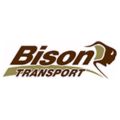
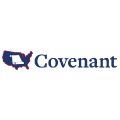

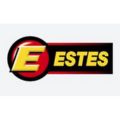
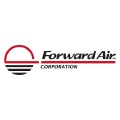
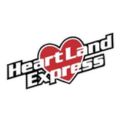

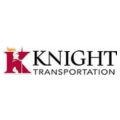
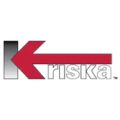



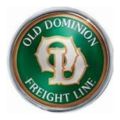








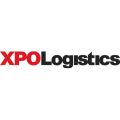
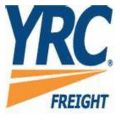
You Are Invited to Contact Us!
If you are interested in our products, services or partnering with us, please feel free to contact us by filling out this form:
or email us at sales@gaorfid.com
